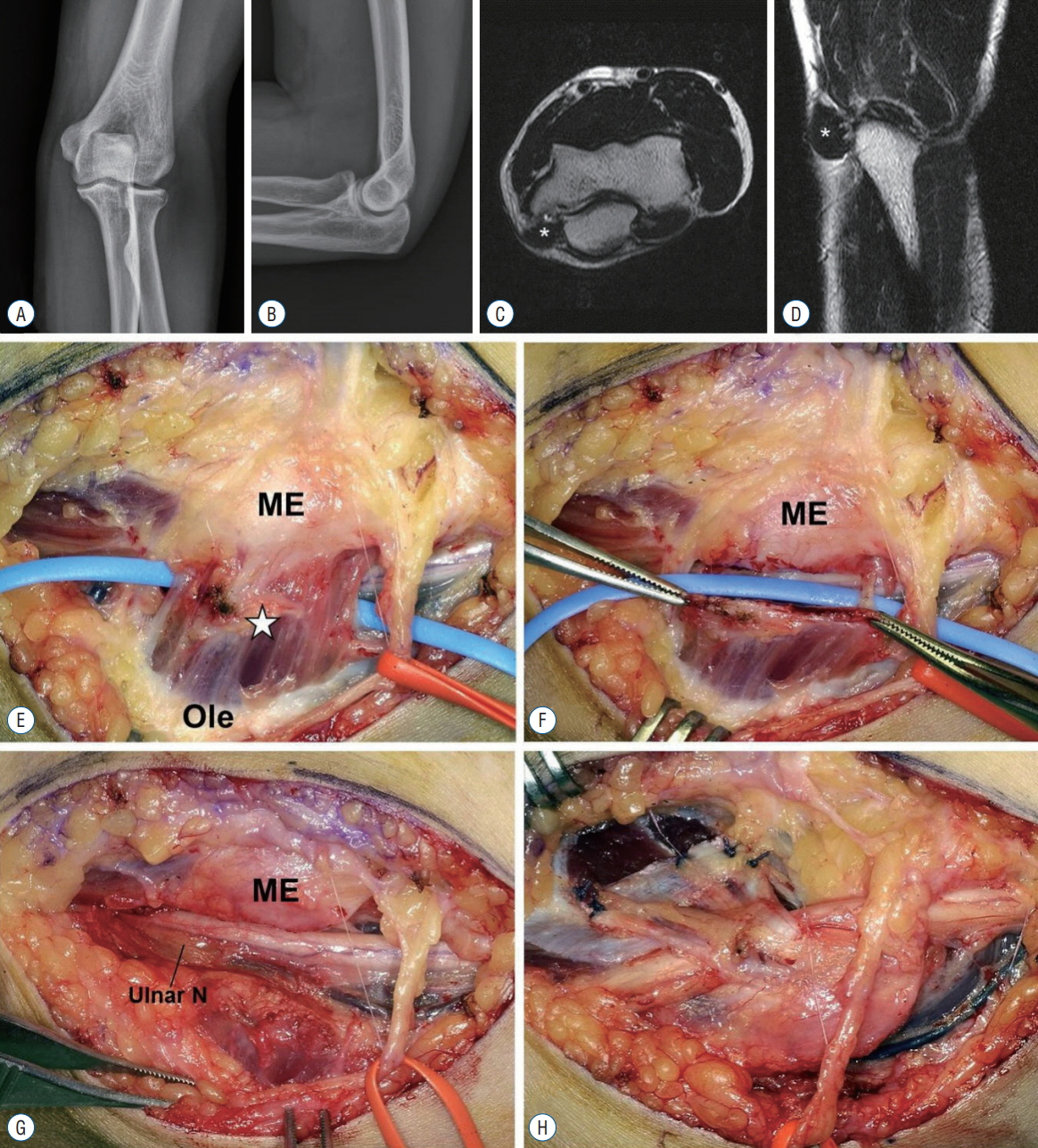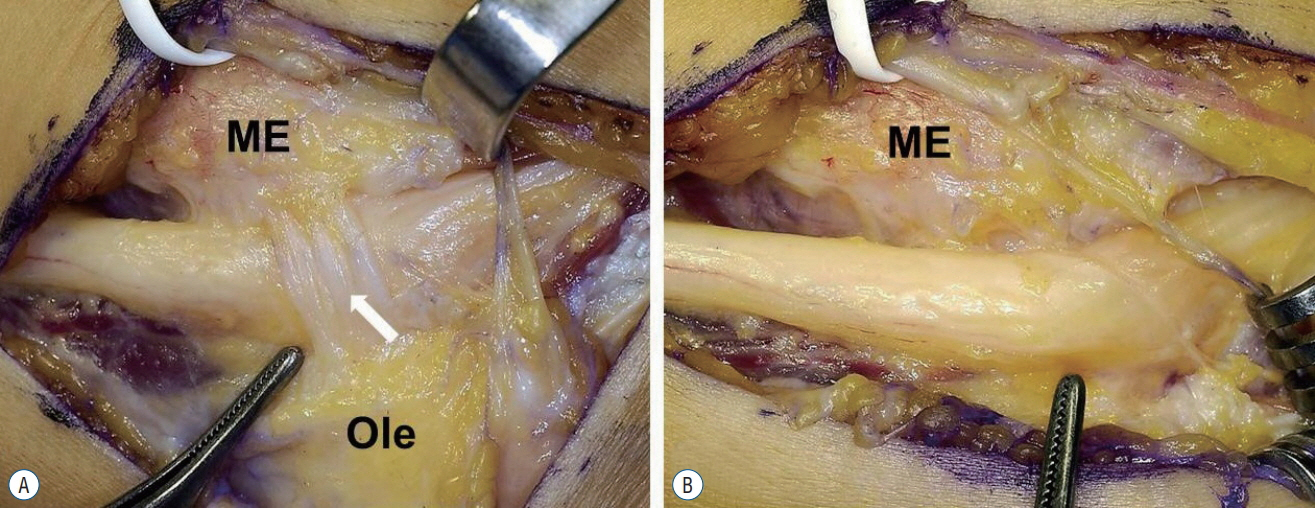J Korean Neurosurg Soc.
2018 Sep;61(5):618-624. 10.3340/jkns.2018.0033.
Cubital Tunnel Syndrome Caused by Anconeus Epitrochlearis Muscle
- Affiliations
-
- 1Department of Orthopaedic Surgery, Bucheon St. Mary’s Hospital, College of Medicine, The Catholic University of Korea, Bucheon, Korea.
- 2Department of Orthopaedic Surgery, Good Samsun Hospital, Busan, Korea.
- 3Department of Orthopaedic Surgery, St. Mary’s Spine & Joint Hospital, Suwon, Korea.
- 4Department of Orthopaedic Surgery, St. Vincent’s Hospital, College of Medicine, The Catholic University of Korea, Suwon, Korea. gamjang@catholic.ac.kr
- KMID: 2420070
- DOI: http://doi.org/10.3340/jkns.2018.0033
Abstract
OBJECTIVE
We evaluated the clinical manifestation and surgical results following operative treatment of cubital tunnel syndrome (CuTS) caused by anconeus epitrochlearis (AE) muscle.
METHODS
Among 142 patients who underwent surgery for CuTS from November 2007 to October 2015, 12 were assigned to the AE group based on discovery of AE muscle; 130 patients were assigned to the other group. We analyzed retrospectively; age, sex, dominant hand, symptom duration, and weakness in hand. Severity of the disease was evaluated using the Dellon classification and postoperative symptom were evaluated using disability of arm shoulder and hand (DASH) and visual analogue scale (VAS) scores. Surgery consisted of subfascial anterior transposition following excision of AE muscle.
RESULTS
AE muscle was present in 8.5% of all patients, and was more common in patients who were younger and with involvement of their dominant hand; the duration of symptom was shorter in patients with AE muscle. All patients showed postoperative improvement in symptoms according to DASH and VAS scores.
CONCLUSION
The possibility of CuTS caused by AE muscle should be considered when younger patients have rapidly aggravated and activity-related cubital tunnel symptoms with a palpable mass in the cubital tunnel area. Excision of AE muscle and anterior ulnar nerve transposition may be considered effective surgical treatment.
Keyword
MeSH Terms
Figure
Reference
-
References
1. Assmus H, Antoniadis G, Bischoff C, Hoffmann R, Martini AK, Preissler P, et al. Cubital tunnel syndrome - a review and management guidelines. Cent Eur Neurosurg. 72:90–98. 2011.
Article2. Boero S, Sénès FM, Catena N. Pediatric cubital tunnel syndrome by anconeus epitrochlearis: a case report. J Shoulder Elbow Surg. 18:e21–e23. 2009.
Article3. Bozentka DJ. Cubital tunnel syndrome pathophysiology. Clin Orthop Relat Res. 351:90–94. 1998.
Article4. Byun SD, Kim CH, Jeon IH. Ulnar neuropathy caused by an anconeus epitrochlearis: Clinical and electrophysiological findings. J Hand Surg Eur Vol. 36:607–608. 2011.
Article5. Capdarest-Arest N, Gonzalez JP, Türker T. Hypotheses for ongoing evolution of muscles of the upper extremity. Med Hypotheses. 82:452–456. 2014.
Article6. Chalmers J. Unusual causes of peripheral nerve compression. Hand. 10:168–175. 1978.
Article7. Cho YJ, Cho SM, Sheen SH, Choi JH, Huh DH, Song JH. Simple decompression of the ulnar nerve for cubital tunnel syndrome. J Korean Neurosurg Soc. 42:382–387. 2007.
Article8. Dekelver I, Van Glabbeek F, Dijs H, Stassijns G. Bilateral ulnar nerve entrapment by the M. anconeus epitrochlearis. A case report and literature review. Clin Rheumatol. 31:1139–1142. 2012.
Article9. Erdem Bagatur A, Yalcin MB, Ozer UE. Anconeus epitrochlearis muscle causing ulnar neuropathy at the elbow: clinical and neurophysiological differential diagnosis. Orthopedics. 39:e988–e991. 2016.
Article10. Fernandez J, Camuzard O, Gauci MO, Winter M. A rare cause of ulnar nerve entrapment at the elbow area illustrated by six cases: the anconeus epitrochlearis muscle. Chir Main. 34:294–299. 2015.
Article11. Gervasio O, Zaccone C. Surgical approach to ulnar nerve compression at the elbow caused by the epitrochleoanconeus muscle and a prominent medial head of the triceps. Neurosurgery. 62(3 Suppl 1):186–192. 2008.
Article12. Hirasawa Y, Sawamura H, Sakakida K. Entrapment neuropathy due to bilateral epitrochleoanconeus muscles: a case report. J Hand Surg Am. 4:181–184. 1979.
Article13. Hodgkinson PD, McLean NR. Ulnar nerve entrapment due to epitrochleo-anconeus muscle. J Hand Surg Br. 19:706–708. 1994.
Article14. Kato H, Hirayama T, Minami A, Iwasaki N, Hirachi K. Cubital tunnel syndrome associated with medial elbow ganglia and osteoarthritis of the elbow. J Bone Joint Surg Am. 84:1413–1419. 2002.
Article15. Lee SU, Kim MW, Kim JM. Ultrasound diagnosis of double crush syndrome of the ulnar nerve by the anconeus epitrochlearis and a ganglion. J Korean Neurosurg Soc. 59:75–77. 2016.
Article16. Masear VR, Hill JJ Jr, Cohen SM. Ulnar compression neuropathy secondary to theanconeus epitrochlearis muscle. J Hand Surg Am. 13:720–724. 1988.
Article17. Morgenstein A, Lourie G, Miller B. Anconeus epitrochlearis muscle causing dynamic cubital tunnel syndrome: a case series. J Hand Surg Eur Vol. 41:227–229. 2016.
Article18. Nellans K, Galdi B, Kim HM, Levine WN. Ulnar neuropathy as a result of anconeus epitrochlearis. Orthopedics. 37:e743–e745. 2014.
Article19. O’Driscoll SW, Horii E, Carmichael SW, Morrey BF. The cubital tunnel and ulnar neuropathy. J Bone Joint Surg Br. 73:613–617. 1991.20. O’Hara JJ, Stone JH. Ulnar nerve compression at the elbow caused by a prominent medial head of the triceps and an anconeus epitrochlearis muscle. J Hand Surg Br. 21:133–135. 1996.
Article21. Posner MA. Compressive ulnar neuropathies at the elbow: I. Etiology and diagnosis. J Am Acad Orthop Surg. 6:282–288. 1998.
Article22. Tiong WH, Kelly J. Ulnar nerve entrapment by anconeus epitrochlearis ligament. Hand Surg. 17:83–84. 2012.
Article23. Uscetin I, Bingol D, Ozkaya O, Orman C, Akan M. Ulnar nerve compression at the elbow caused by the epitrochleoanconeus muscle: a case report and surgical approach. Turk Neurosurg. 24:266–271. 2014.24. Wilson TJ, Tubbs RS, Yang LJ. The anconeus epitrochlearis muscle may protect against the development of cubital tunnel syndrome: a preliminary study. J Neurosurg. 125:1533–1538. 2016.
Article
- Full Text Links
- Actions
-
Cited
- CITED
-
- Close
- Share
- Similar articles
-
- Cubital Tunnel Syndrome by Anconeus Epitrochlearis in an Adolescent
- Ultrasound Diagnosis of Double Crush Syndrome of the Ulnar Nerve by the Anconeus Epitrochlearis and a Ganglion
- Comparison of Cubital Tunnel Syndrome with or without Anconeus Epitrochlearis: Are They Different?
- Tardy Ulnar Nerve Palsy Secondary to the Anconeus Epitrochlearis Muscle: 2 Case Report
- Ulnar Neuropathy due to Cubital Tunnel Syndrome Caused by Anconeus Epitrochlearis: A Case Report



